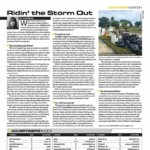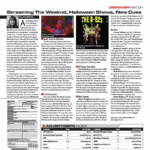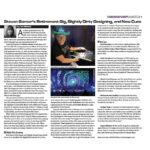In between tours, over the past few decades, LD Joel Reiff has been writing. He selected 14 of his favorite short stories for his first published paperback, 14 Shorts and Other Dirty Laundry. PLSN found Reiff on the road with Peter Frampton, soon to head out again with Jason Mraz in August, to answer a few questions about his literary aspirations and inspirations.
The stories are not inspired by his true road tales, Reiff said, but are fictional. “They run the gamut from a man who refuses to accept his future, to a boxer with a secret, to a dreamer who cherishes love more than life, to a story about the end of the world,” he explained, touching on overviews.
“Strange scenarios just pop into my head, and I want to follow the thread,” he told PLSN, describing what sets the scene for a story. “I’ve always loved stories with surprise twists at the end, so I tend to do that as well. One thing I don’t want to be is predictable. Plus, it’s a great way to get out all those dark thoughts and blame them on someone else, namely a fictional character. It’s always healthier to murder someone on a page; that way they call it art.”
Though Reiff does have actual road stories inspired by road life, which “may someday see the light of day,” these stories bear no resemblance to himself or real life. “The stories in the book are nothing like me. My wife reads them and wonders where the hell they come from. By the end of the book, if it was me in those stories, I’d have consecutive sentences in prison, mostly on death row.”
He can sometime find time to edit his writing while on tour, but the creative process requires being alone and in a quiet place, which is “not always conducive to the road setting.”
An avid reader of mysteries and noir, Reiff finds no comparison of his writing style to any of his literary heroes. “I only aspire to be nearly as good as those that I enjoy to read. I’m a big fan of the Holy Trinity of Mystery Writing: Raymond Chandler, Dashiell Hammett and Ross MacDonald.” He also counts authors John Steinbeck, Dennis Lehane, Timothy Hallinan and Jonathan Tropper among his favorites.
For Reiff’s book, go to www.plsn.me/1rBvt82.
Ravitz at the Drive-In
Jimmy Buffett & The Coral Reefer Band helped bring a resurgence of patrons to the iconic American institution recently with their “Live At The Drive-In.” The live performance took place June 19 at the Coyote Drive-In in Fort Worth, TX, which was simulcast that night to more than 80 participating drive-ins around the country. The goal was to reach fans in markets outside of his normal tour itinerary.
LD Jeff Ravitz was brought in as broadcast lighting consultant to work with Buffett’s touring LD Steve Hoover. Ravitz’s role was to help translate the tour’s show design to television.
PLSN asked Ravitz about the challenges of the venue. “Our setup was a small mobile stage—but not small by mobile standards: about 40 feet wide, 38 feet deep, plus PA wings. It was parked directly in front of the drive-in screen and was high enough to cover the bottom half of the screen. In front of the stage was a small lawn that accommodated around 900 standing people. Behind them were the FOH mix and spot towers. Interspersed between the towers were around 50 classic cars with their owners dressed in ‘50s and ‘60s outfits or Jimmy Buffett-esque grass skirts, parrot head hats and other tropical styles. Then, the rest of the lot was filled with regular cars (and one Prius), with people tailgating or watching the show from the roofs of their cars.
“We devoted a lot of lighting resources to making sure the classic cars looked good on camera, as well as the tall trees that form a wall around the drive-in.”
The lighting levels between TV and the live show needed balancing, Ravitz explained. “For the live show design, there can be extreme variations in lighting levels across the stage—greater than the camera can deal with all at the same time–and that can create issues for the creating a balanced screen picture. So I worked with Steve Hoover, the tour LD, to fine-tune those levels. We also wanted to see the skyline of Fort Worth in a wide shot that showed the entire drive-in with some skyscrapers in the background. That meant our overall lighting levels had to be more contained so the camera could properly see the stage and the buildings at the same time.”
“A lot of the angles that look good for the live audience aren’t flattering when you see it on the talent in a close-up view that’s so much more detailed than anyone in the live audience would ever see. This show was definitely not the regular tour setup for the Jimmy Buffett show. Everything was incredibly squeezed tight and the height of the lighting on this mobile stage was much lower and closer to the band than anyone would want. So, I suggested angles that addressed that concern and also retained the needs of the original show.
“Then, some of the colors, even subtle ones that are on people’s faces onstage, can appear strange and exaggerated on-camera. I’ll advise on those adjustments, too and also deal with followspot color correction. Finally, for the stage version of the show, there are often parts of the stage that aren’t given much lighting attention, because the visual priorities are different. I’ll try to carefully add lighting where needed to make more of a pictorial composition for the camera. For this show, I did that by lighting the trees, the cars and adding some lighting to the audience so the edges and backgrounds of various camera shots had interesting detail to fill them in.”
Of course there are challenges in pulling off a show in a venue not equipped for live shows.
“When you’re doing a show in what is essentially a big open field, every lighting position has to be created from the ground up, literally. We built truss towers around the audience area that accommodated lights for the audience and the trees, but were low-profile enough to not block the view of the trees. Followspots had to be on scaffold towers, but those are never high enough to be at the angle we really want. Unfortunately, they were so low that the resulting angle was practically straight on—definitely not ideal. So, we placed the towers widely-spaced apart to attempt to create some facial contours that look better on-camera. It wasn’t perfect, but you know, every little step we take in that direction helps.
“It’s obvious that in an open field there are no catwalks to get up to focus or fix lights. So we used huge and very slow-moving condors and scissor lifts to reach the lights. The process can be painfully slow and awkward. We had one of our two condors spring a leak in a hydraulic hose, which put us at a distinct disadvantage. Also, power is provided by generator, and there’s always a chance of failure.”
Reflecting back on the event, Ravitz summed it up: “Finally, did I mention how pleasant it is to set up all day in the Texas sun and then focus at night with June Bugs crawling up your leg?” Indeed.
For news reports and video on the event from the Fort Worth Star-Telegram, visit www.plsn.me/1xuCRna.
Share your news with Debi Moen at dmoen@plsn.com


